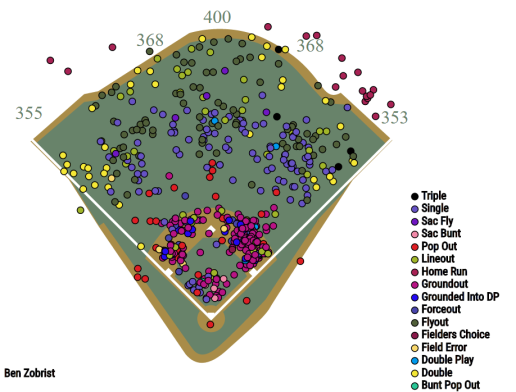As Spring Training begins, Talk Cubs is starting a series highlighting each position on the Cubs, from First Base to the Bullpen. Talk Cubs will be posting a new position each day, and each preview includes last season’s stats, projections for 2017, and possible injury replacements. Position by Position gives fans a better idea of what the 2016 World Series Champions will look like in 2017 as Spring Training unfolds.

A tough decision lies ahead for Joe Maddon and the coaching staff as they will try to figure out who will be pairing with Addison Russell in the middle of the infield this year. Who do they want to start at second base? The 2016 World Series MVP? Or the 2016 NLCS MVP? For most teams, that person would be the same player, but with the depth the Cubs have in the infield, both Ben Zobrist and Javier Báez are competing for the spot. Both are equally deserving: Zobrist has an incredibly reliant offensive track record and Báez has a high ceiling, not to mention spectacular defensive ability. So who should get the majority of starts at second?
Zobrist and Báez took different paths to the majors. Zobrist, an Illinois native, was selected in the 6th round of the 2004 amateur draft by the Astros but didn’t debut until 2006 after he was traded to Tampa Bay. He struggled his first three years in the majors, accumulating -0.4 fWAR in 145 games in the majors. He had a breakout season in 2009, slashing .297/.405/.543 and hitting 27 homers while driving in 91 RBI. He achieved his first All-Star selection, placed 8th in AL MVP voting, and was worth an outstanding 8.6 fWAR. Over the next seven seasons, Zobrist averaged 4.62 fWAR per year, received two more All-Star selections, and won two World Series in five trips to the postseason. Before the 2016 season, he signed a 4 year $56M contract with the Cubs through his age 37 season.

Báez, on the other hand, was the 9th overall pick of the 2011 draft, a remnant of the pre-Epstein regime. Báez spent the better part of his first four years in the minors, but he arrived in the majors with a splash when he homered in his debut to give the Cubs a win. He has the flare of a first round pick and the strikeout rate (29.9% in MLB) of a High-A slugger. Across three years in the majors, Báez has appeared in 222 games, though only recorded 759 PA’s, and has swatted 24 home runs. 2016 was by far his best season, where he played in 142 games (450 PA’s) and slashed .273/.314/.423 while accumulating 2.7 fWAR. His real contributions in 2016 came from his defense, where he was within one DRS of the second base leader Dustin Pedroia. While Báez had 11 DRS to Pedroia’s 12 DRS, Báez did it in 30% fewer innings. If Baez played a full season at second and kept up the same rate of saving runs, he would have saved over 33 runs last year, surpassing last year’s DRS leader Mookie Betts.

So who would the Cubs rather have at second for most of the season? The grizzled veteran who puts up reliable offensive numbers but does not rate well defensively (-3 DRS at 2B last season) or the young stud who strikes out too much but plays some of the best defense in the league? The answer might be a little simpler than previously thought.
****
Think about it. A second base platoon where one player provides excellent offense and the other outstanding defense. With Báez and Zobrist, this platoon could not only be possible but could be extremely effective. So how do we decide who starts against whom? Though not necessarily a primarily offensive powerhouse, Báez hit lefties very well last year. Though he only had 122 AB’s against lefties in 2016, his batting average was 53 points higher against lefties, not to mention that his wRC+ (runs per plate appearance, scaled to 100) was significantly better against lefties (124 wRC+ with 100 being average) than righties (82 wRC+).
Zobrist, meanwhile, had a lower batting average against righties, 40 points lower in fact, but had more power against righties, hitting 10 more home runs last year. The fact that Zobrist is a switch hitter provides more value, as pitching changes would affect Zobrist less than Báez. In fact, Zobrist might actually do better against a lefty reliever. While his wRC+ was lower against righties (123 against righties as opposed to 129 against lefties) Báez’s outstanding defense and significant splits in favor of hitting lefties would counteract what Zobrist loses by only hitting righties.

In Báez, the Cubs have an excellent defender who hits lefties well and has good K% (18.4%) and BB% (8.1%) against them, while Zobrist has more power against righties, even if he does have a significantly lower batting average. As a result of platooning them, each player would be used somewhat regularly. Using them regularly could increase the effectiveness of defensive changes in games (Báez coming in for Zobrist with a lead) and offensive changes (Zobrist coming in for Báez when they need to get going at the plate) which gives Maddon more moves to make late in games. While the lefty-righty platoon would help Báez the most, Zobrist would still stand to benefit against righties with his increased power.
In the end, the Cubs are in an excellent position at second with two potential All-Stars, not to mention the depth in the minor leagues with Ian Happ and others. If either Zobrist or Báez were injured, the replacement at both the major league level and minor league level would be excellent, and second base looks like one of the strongest positions for the Cubs going forward.

You must be logged in to post a comment.